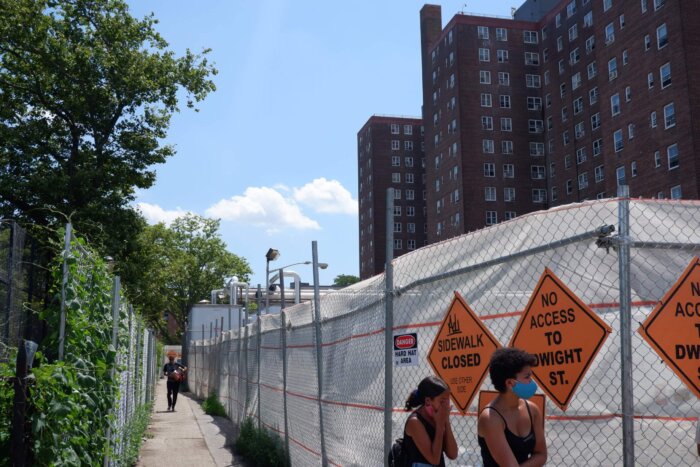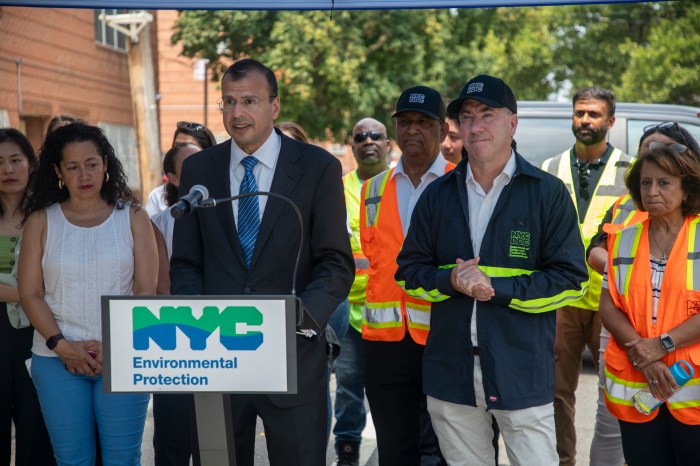More than 13 years after Hurricane Sandy, Red Hook Houses East has received more than $1.3 million in federal funding for permanent storm-related repairs.
The funding was allocated eight years after the Federal Emergency Management Agency allocated $438 million for a recovery and resiliency project at Red Hook Houses, and nearly five years after the project it’s paying for – a restoration of a small building on Columbia Street – was completed.
According to a NYCHA spokesperson, the $1.3 million was awarded for a renovation and repair job at Building 29, including new mechanical and electrical equipment and restored architectural finishes.

After the restoration was finished in 2019, NYCHA moved some small businesses from the adjacent Building 28 into the first floor of Building 29 as they prepared to demolish and rebuild Building 28.
When Hurricane Sandy hit in October 2012, flooding knocked out heat and electricity at Red Hook Houses, Brooklyn’s largest public housing complex, for weeks.
The extent of the damage became clear when floodwaters receded — the roofs of all 28 residential buildings at Red Hook Houses needed to be replaced, boilers and electrical equipment were wrecked — the storm had touched almost every part of the complex.
FEMA allocated its first round of funding for Red Hook Houses in 2016, four years after the storm, and the city started repairs at the complex the following year.
According to NYCHA’s Sandy Transparency Map, the recovery project at Red Hook Houses is set to be finished this year.
Along with repairing storm damage, the agency has spent the past several years installing resiliency measures to prevent and prepare for future floods — the new Building 28, for example, now holds a “resilient state-of-the-art heat and hot water system” and new backup generators.
In the years before the repairs started — and in the years since — Red Hook Houses residents have grappled with the long-term effects of the storm, including leaky roofs and mold. Outside, residents said scaffolding, construction fences, and temporary boilers made the complex “unbearable.”

“There’s no question that the work and the recovery from Sandy, especially in Red Hook Houses, has simply taken too long,” said U.S. Rep. Dan Goldman, who announced the FEMA funding on Jan. 29. “With this grant, and with the final stretch run with the other recovery work, we are very hopeful that life can return to more normalcy for the residents.”
Goldman explained that the appropriations process for FEMA funding can be “cumbersome,” especially in instances where the city would have had to make a supplemental application for additional funding.
Though the recovery process has been lengthy, Frances Brown, president of the Tenant Association at Red Hook East, said she has gotten regular updates from NYCHA and the contractors — and that things are starting to look finished.
“It looks like things are coming to a close, things are starting to look really nice because they’re starting to open up our areas out there where they were working,” she said.
The unfinished work has already benefited the community, Brown added. She said no tenants complained about flooding during Hurricane Ida in 2021, or when the city was inundated by Tropical Storm Ophelia last fall.
“The way the contractors have built up Red Hook East … when the water has to flow straight out,” she said. “It’s not going to back up in the apartments. They did all the basements over, and I’m content with that.”

With the Sandy-related projects nearly, both Goldman and Brown said more work is needed at Red Hook Houses East. For one thing, Brown said, she’d like to see new doors and windows installed — she’s had the same old windows for three decades, she said.
“The Red Hook Houses were built in [1939], and have never been fully renovated,” Goldman said. “You have 85-year-old pipes and other infrastructure.”
Last year, Goldman signed on to a new bill introduced by U.S. Rep. Nydia Velázquez – the Public Housing Emergency Response Act, which would designate $70 billion in federal funds to be distributed to public housing authorities around the country.
Based on capital needs, $32 billion would head right to NYCHA.
“[The FEMA grant] is one funding stream that that the city is trying to take advantage of, but the needs are so much greater than what is included in this,” Goldman said. “We’re working hard to push for this bill to be teed up for the next Congress, when we hopefully take over the majority.”























